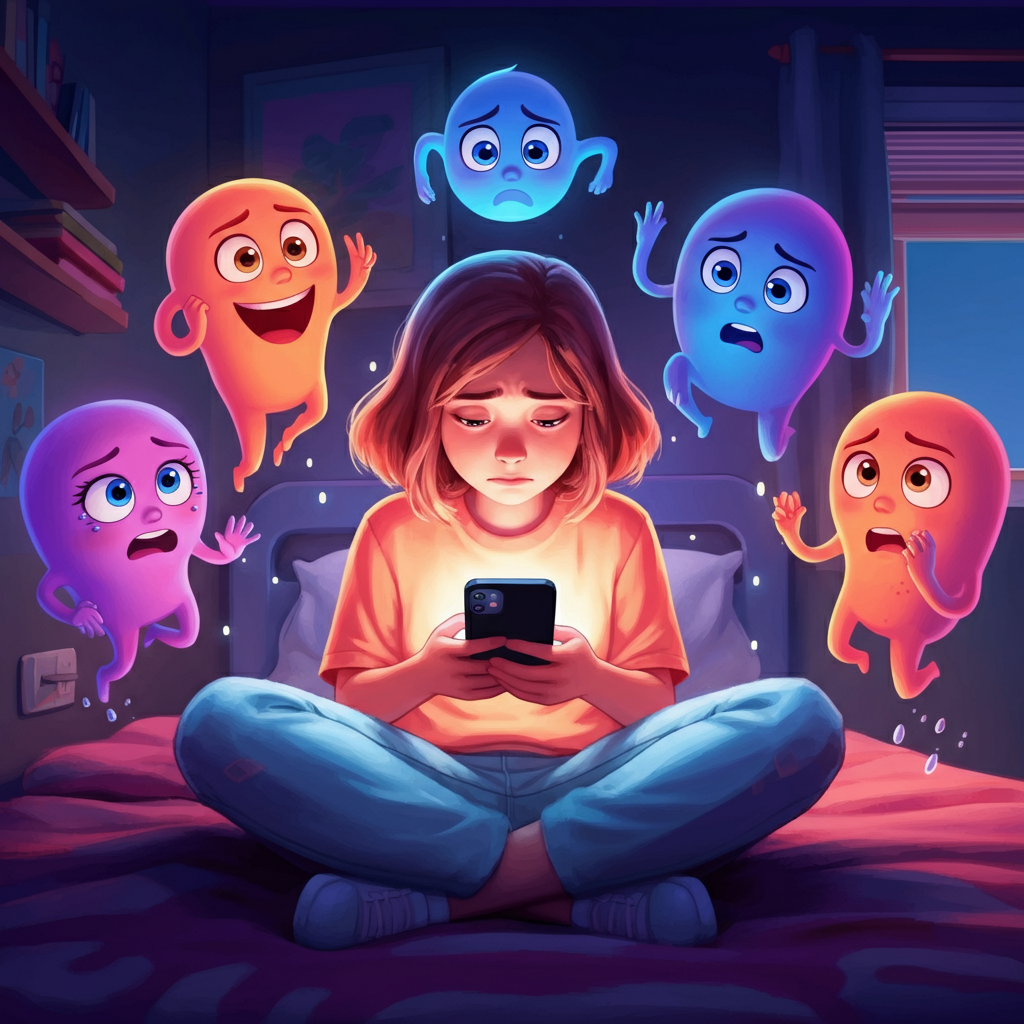Since the debut of the original Inside Out in 2015, the movie has captivated audiences with its imaginative portrayal of emotions. Fast forward to the sequel, Inside Out 2, and we find ourselves navigating a very different, yet highly relevant challenge—phone obsession. The title, Inside Out 2 Glued to Phone, captures the essence of a digital dilemma that resonates with today’s audiences. This article explores the themes, impact, and lessons that this sequel brings to the modern family dynamic.
The Changing World of Riley
Riley, the central character of Inside Out 2, is no longer the wide-eyed elementary schooler we met in the first film. She’s now stepping into her teenage years, a time loaded with emotional and social complexities. One of the key additions to her life in this sequel is something many teenagers can relate to—a smartphone. The phrase “glued to phone” could not describe her relationship with the device any better.
With her phone becoming an essential part of her everyday life, Riley relies on it for more than just staying in touch with friends. Social media, games, and instant access to a world of information are all at her fingertips. However, this glowing screen also represents a new set of challenges—distraction, addiction, and diminishing face-to-face interactions.
The phone serves as a critical backdrop to Riley’s emotional landscape in the movie, posing questions about how technology influences human connection and emotional development.
The Role of the Phone in Riley’s Emotional Journey
Joy Meets the Digital Age
One of the standout scenes in Inside Out 2 Glued to Phone depicts Joy, one of Riley’s primary emotions from the first movie, grappling with her inability to spark the same happiness through non-digital activities. The device becomes both a source of excitement and a rival for Joy’s influence. With one swipe, Riley experiences bursts of dopamine from likes and notifications—reactions that Joy used to easily elicit through simpler pleasures like playing hockey or spending time with her family.
This emphasizes a question many families face today: what happens when digital joy supplants real-life experiences? While the phone provides instant gratification, the deeper, longer-lasting moments that create joyful memories often take a backseat, a trade-off explored poignantly throughout the film.
Sadness, Fear, and the Impact of Screen Time
The emotions of Sadness and Fear also play heightened roles in this sequel. Sadness often surfaces when Riley becomes overwhelmed by online comparisons, while Fear grows as she navigates unfamiliar pressures, such as cyberbullying or worrying about how others perceive her online persona.
By weaving these emotions into the narrative, Inside Out 2 Glued to Phone encourages viewers to reflect on how excessive phone use amplifies these feelings. It’s a subtle but powerful message about the need to monitor how technology impacts emotional well-being—especially in young minds.
Themes That Hit Home
Social Media and Validation
A key aspect of Riley’s phone usage in the movie centers on social media. Whether she’s scrolling through posts or obsessively checking likes on her photos, it’s clear that Riley’s attachment to her phone is fueled by a quest for validation. This highlights a critical issue for teens and adults alike—the pursuit of digital approval at the expense of real-world self-esteem.
The film manages to toe the line between thoughtful critique and relatability. It doesn’t demonize social media outright but rather encourages audiences to consider the balance between online and offline interactions.
Family Connections in the Digital Age
Despite her glued-to-phone tendencies, Riley’s character arc eventually explores how her emotional growth hinges on reconnecting with her family. This subplot resonates deeply in today’s world, where conversations over dinner are often interrupted by text messages, notifications, or viral videos.
The resolution in Inside Out 2 Glued to Phone emphasizes the importance of unplugging, even if just for a while, to restore bonds and foster meaningful connections. It’s a solution many viewers—especially families—can take to heart.
The Power of Mindful Connection
The movie also introduces mindfulness as a counterbalance to phone dependency. A moment when Riley sets her phone aside to fully engage with a heartfelt conversation serves as a turning point. It underscores a growing societal realization—the need to disconnect to truly reconnect with ourselves and others.
Psychological Insights on Phone Use
While Inside Out 2 Glued to Phone provides entertainment, it also delivers thought-provoking commentary supported by real-world psychology. Studies have repeatedly shown that excessive phone use can lead to increased anxiety, reduced attention spans, and diminished emotional intelligence. For teenagers like Riley, who are already navigating hormonal and psychological changes, constant exposure to screens can intensify these effects.
The movie brilliantly visualizes how Riley’s emotions are directly influenced by her interactions with her phone. It’s an effective, age-appropriate way of demonstrating the cognitive and emotional toll of being locked in a digital world.
What Inside Out 2 Teaches Us About Balance
The message of Inside Out 2 Glued to Phone isn’t about rejecting technology altogether. Instead, it advocates finding balance. Riley’s story is relatable precisely because it mirrors the everyday challenges families encounter with digital devices.
- Set Boundaries: Whether it’s screen-free dinners or designated “unplugged” times, establishing rules around phone usage can help maintain healthy habits.
- Encourage Alternative Activities: The movie shows the joy Riley rediscovers through non-digital activities. This encourages viewers to explore hobbies or engage in creative endeavors outside their screens.
- Foster Conversations: Parents can use the themes in the film as a springboard to talk to their children about the pros and cons of technology, helping them feel supported while navigating the digital landscape.
Why It Matters
At its core, Inside Out 2 Glued to Phone serves as a touching, meaningful commentary on the digital dilemmas many families face. Its blend of humor, heart, and relatability ensures that its lessons will stick with audiences long after the credits roll. The movie inspires viewers to examine their own relationships with technology while re-emphasizing the timeless importance of real-world connections.
By shining a light on this modern issue, the film not only entertains but educates, leaving audiences better equipped to tackle the challenges of balancing the digital with the emotional.
Closing Thoughts
Inside Out 2 Glued to Phone is a wake-up call that delightfully mingles empathy with perspective. Through Riley’s experiences, we’re reminded of the importance of tuning into our emotions, putting down our devices, and prioritizing meaningful interactions. It’s a must-watch for anyone eager to explore how technology shapes—and sometimes complicates—the human experience.
If nothing else, the movie encourages us to do something simple yet profound. Take a moment, look up, and reconnect. Who knows? The stories unfolding around us might be far richer than anything found on a screen.



